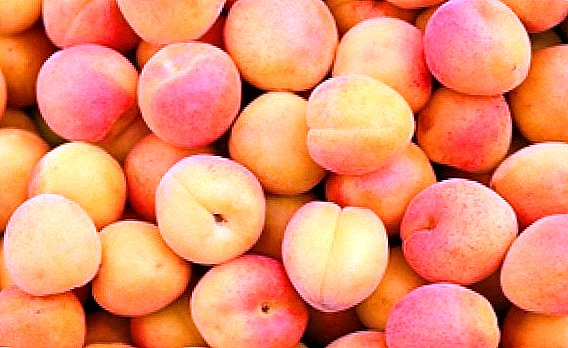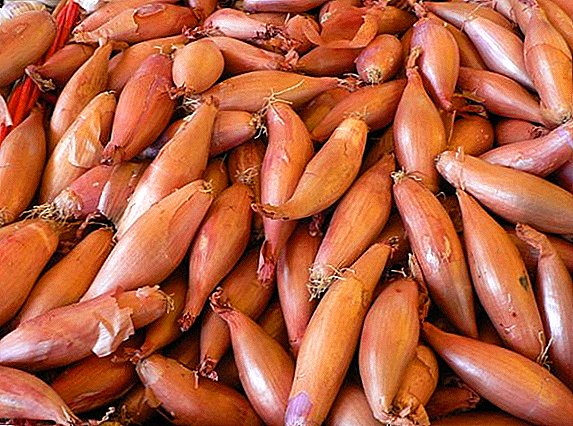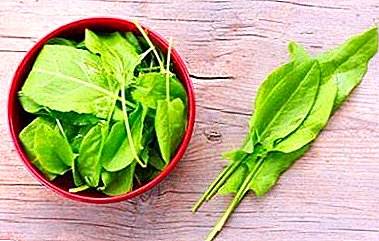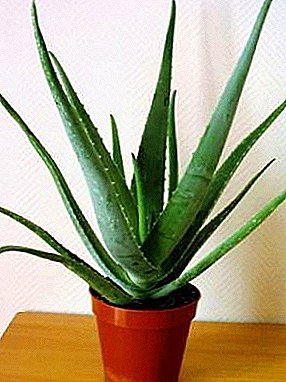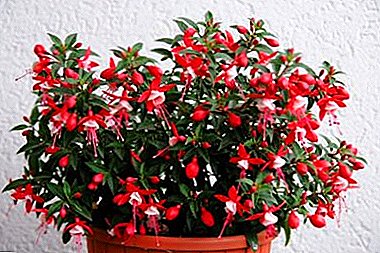
Fuchsia is quite popular both indoor and garden flower, many gardeners try to get it with all their efforts, and all because this plant is very beautiful, and its flowering lasts a long time, so you can enjoy beauty for a long time. Also, it can be emphasized that fuchsia does not require strict care, unlike many other indoor plants.
General provisions
Under the conditions of existence, fuchsia is not capricious, but still there are certain growing conditions. Fuchsia prefers to grow in close pot, therefore, transplantation should be done only when the plant will be "butt".
Fuchsia will need to be transplanted into a pot more than the previous 3-4 centimeters, the pot should be chosen preferably plastic and light, because this flower does not tolerate heat and can easily get burned, and the light pot less attracts the sun's rays. The plant requires frequent watering, the soil should always be hydrated, in addition to watering should be sprayed leaves with water.
A plant with sprayed leaves should not be exposed to the sun, as there is a risk of getting burned by the plant.
How to grow?
From seed
If you decide to grow a flower from seeds, then you should consider all the features of growing:
 At the very first stages of formation, the seeds should be planted in a small box or cup with the soil consisting of turf, peat and sand (in a ratio of 3: 2: 1). You should not use any fertilizer for seeds at first, you can only treat the soil in which the seeds will be planted with a weakly concentrated solution of potassium permanganate.
At the very first stages of formation, the seeds should be planted in a small box or cup with the soil consisting of turf, peat and sand (in a ratio of 3: 2: 1). You should not use any fertilizer for seeds at first, you can only treat the soil in which the seeds will be planted with a weakly concentrated solution of potassium permanganate.- The seeds of this plant can be purchased at a flower shop, but you can get them yourself, for this you need to choose the already blooming fuchsia, choose two flowers from it (fatherly and maternal), then you should remove the anthers on them to pollinate. During the breeding process, pollinated flowers should be covered with cloth bags. Approximately in a month, the fruit received after pollination becomes ready, it should be dried and seeds should be pulled out of it.
In March-April, the most optimal time for sowing seeds, at least for their own, at least for the store. Seeds are simply poured into sifted peat in boxes or glasses, and then the dishes are placed in trays of water so that the soil is well saturated with moisture. Then the seeds are mixed with sand and sown in the ground. Cover the dishes with seeds with a film and leave for 3-5 weeks.
- Seeds, covered with foil, must always be in wet conditions, so the soil should be soaked with water using a pallet. Lighting should be moderately bright and diffused. The temperature should be maintained around +20.0WITH.
After the second leaflets appear on the seedlings, they should be seated in separate plastic cups with holes at the bottom. Watering them should be moderate. Over time, when the plant becomes crowded in a glass, it will need to be transplanted into a larger pot.
With seedlings you need to be very careful and you need to transplant them, leaving whole earthen clods.
- During the growth of fuchsia, it is necessary to constantly pinch so that the plant is lush, and its flowering looks much more elegant. When growing a flower from seed, it needs to ensure constant wintering. From the end of November you need to lower the temperature of the habitat of fuchsia to + 5-100C. And also, by winter the plant should be cut off.
In the garden
Fuchsia cannot grow constantly in the garden due to winter frosts (some hybrids are an exception), therefore for the winter period the fuchsia will need to be transplanted into a pot and transferred to a room, this should be taken into account when planting in a garden. More information about the features of wintering fuchsia we wrote here.
 Growing fuchsia in the garden is difficult enough, so you need to take into account factors and features, such as:
Growing fuchsia in the garden is difficult enough, so you need to take into account factors and features, such as:
- To the soil, this plant is unpretentious, but still, fuchsia prefers a light soil with neutral acidity. The soil must be fertile and well hydrated. Adult plants can be fertilized with complex chemical fertilizers, as well as natural compost or humus.
- When growing in a garden, preference should be given to proven store seeds. Sowing seeds should be carried out in March in order to plant a plant in the garden in May. For the germination of seeds, it is desirable to use a transparent, spacious plastic utensils.
At the very beginning, the soil needs to be sprayed with a weak solution of potassium permanganate, and then it must be constantly kept wet. This container with soil and seeds should be covered with foil and kept at a temperature of about +20.0WITH.
- In order to form a flower with a bush, it is necessary to cut fuchsia and nip, as this will help cultivation. A nip of a plant is carried out in 3 stages, each of which takes about a month. At each stage, the removal of the upper part of each of the branches is carried out, this is necessary in order for the plant to grow in breadth and for the number of flowers to double.Pruning is done mainly for indoor fuchsias, it occurs in two stages - autumn and spring. In autumn, the parts that had flower stalks were cut from the plant. In the spring, all frail and dry parts of the flower are completely removed.
Aftercare
In the future, the plant special care is required. The main thing is to maintain a normal level of soil moisture and leaves, with an insufficient level, you need to water the plant or spray the leaves.
Fuchsia should not grow in a draft and in the open sun, as its leaves are sensitive to these factors. Also, it is necessary to carry out periodic top dressing of the soil with both chemical mineral and organic fertilizers. During flowering plants require fertilizing with instant complexes.
More information about home care for fuchsia and in the garden can be found here.
Possible diseases
 Usually fuchsia is not exposed to any diseases and any pests, especially with proper care of the plant. However, it can sometimes be affected by powdery mildew, black or gray rot. It is easy to get rid of these evils - it is enough just to remove the diseased part of the plant in time and process the rest of the fuchsia with specialized chemicals.
Usually fuchsia is not exposed to any diseases and any pests, especially with proper care of the plant. However, it can sometimes be affected by powdery mildew, black or gray rot. It is easy to get rid of these evils - it is enough just to remove the diseased part of the plant in time and process the rest of the fuchsia with specialized chemicals.
The state of fuchsia is easily recognizable by the color of the leaves, bright green means that the plant is just enough, the shade of yellow makes it clear that the plant needs some substances.
From pests to the plant can harm the aphid and spider mite, with them will help cope plant treatment with insecticides.
Conclusion
Fuchsia is a very beautiful and elegant flower. The fuchsia plant is unpretentious and is not afraid of almost any diseases and pests, so it can live in various conditions. Fuchsia is perfect for all lovers of beauty, many gardeners and flower growers will appreciate its beauty.


 At the very first stages of formation, the seeds should be planted in a small box or cup with the soil consisting of turf, peat and sand (in a ratio of 3: 2: 1). You should not use any fertilizer for seeds at first, you can only treat the soil in which the seeds will be planted with a weakly concentrated solution of potassium permanganate.
At the very first stages of formation, the seeds should be planted in a small box or cup with the soil consisting of turf, peat and sand (in a ratio of 3: 2: 1). You should not use any fertilizer for seeds at first, you can only treat the soil in which the seeds will be planted with a weakly concentrated solution of potassium permanganate.


